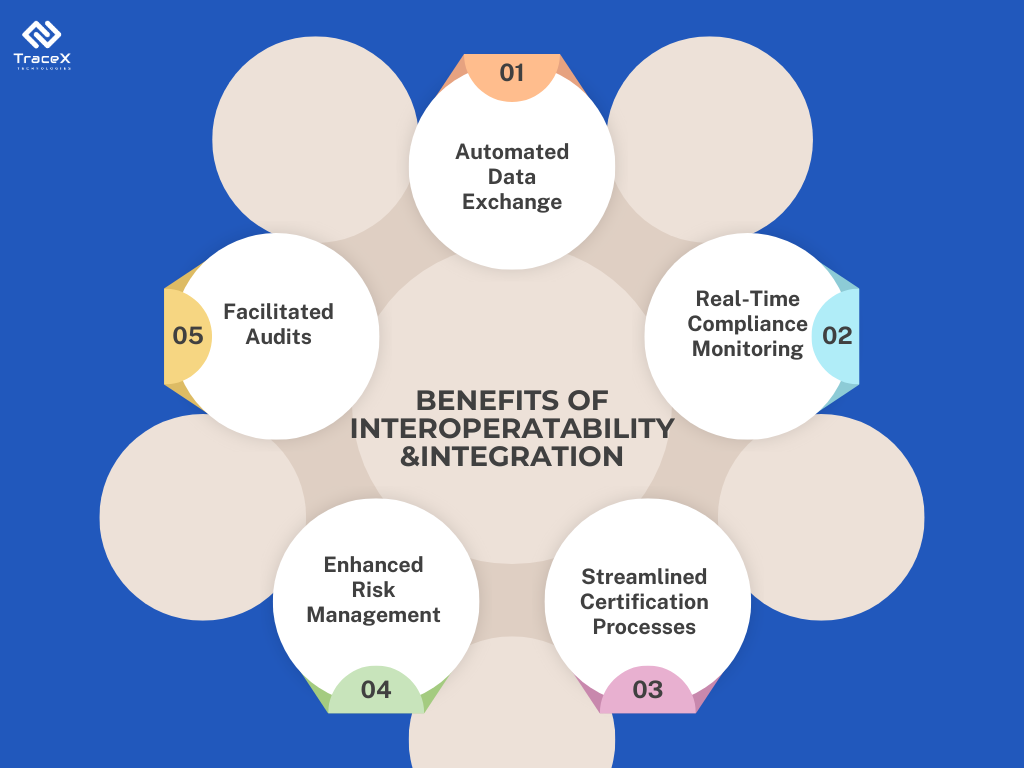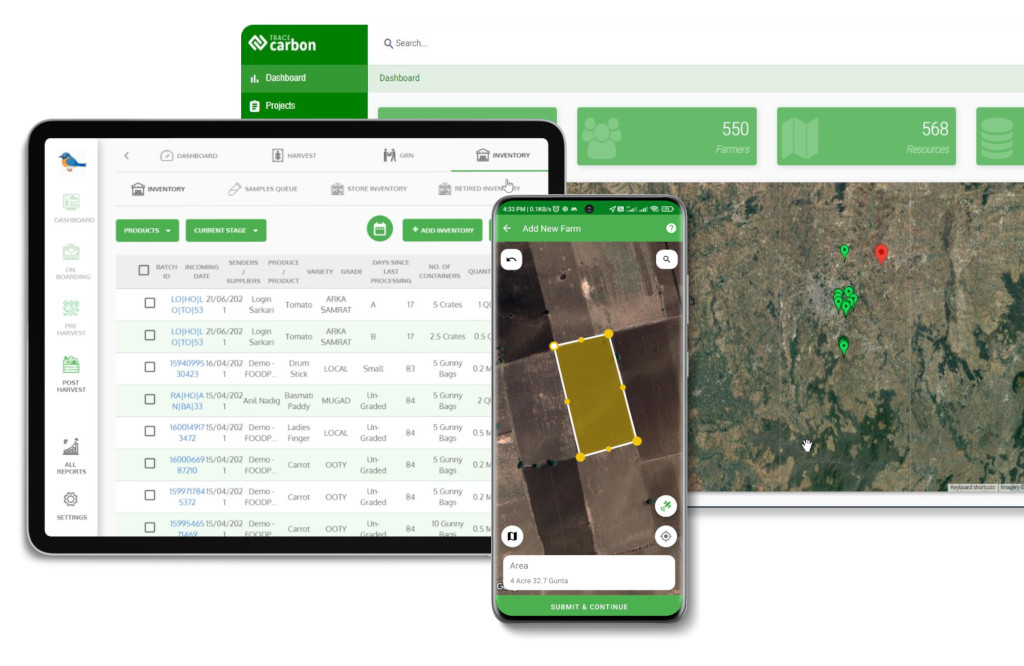Contact: +91 99725 24322 |
Menu
Menu
Quick summary: Discover how interoperability and integration play a crucial role in achieving EUDR compliance and driving sustainability in supply chains. Learn how TraceX's platform leverages blockchain and API integrations for seamless data management and reporting.

Interoperability and integration in EUDR solutions ensures that compliance platforms work effortlessly with existing ERP, procurement, and certification systems. By leveraging open APIs and standardized data formats, these solutions eliminate operational disruption, allowing businesses to maintain current workflows while adding traceability, geolocation validation, and automated DDS filing. This reduces implementation costs, minimizes training time, and ensures supply chain data flows securely across systems without duplication or errors. For exporters and importers, interoperable and seamless integration means faster adoption, continuous compliance, and zero downtime while meeting stringent EUDR requirements.
For many exporters and importers, one of the biggest hesitations in adopting EUDR compliance technology is the fear of having to replace or overhaul existing ERP, procurement, or certification systems. These systems are deeply embedded in day-to-day operations, and any disruption could mean costly downtime, retraining, and operational risk.
Interoperability is no longer a “nice to have”—it’s a core capability of leading EUDR solutions. Modern platforms are built with open APIs, modular architecture, and data mapping layers that integrate directly with SAP, Oracle, Microsoft Dynamics, or certification systems like FSC and PEFC.
Key Takeaways
See How Seamless Integration Transformed EUDR Compliance!
Discover how TraceX enabled end-to-end traceability by integrating SAP, MES, and AS400, ensuring real-time tracking, automated compliance, and regulatory-ready reporting for a global tire manufacturing company.
Read the case study
At its core, interoperability is the ability of different systems, organizations, and applications to work together seamlessly. In the context of EUDR, it refers to the capacity of various entities within the supply chain—ranging from producers and suppliers to regulators and auditors—to share, access, and process data effectively and efficiently. This ensures that all parties are on the same page, using the same data and working towards the same compliance goals. While interoperability ensures that different systems can work together, integration takes this a step further by ensuring that these systems can operate as a unified whole. In the context of EUDR, integration is essential for creating a seamless and efficient compliance process, particularly when dealing with complex and fragmented supply chains.
Interoperable and integration ready EUDR solutions are compliance platforms purpose-built to connect seamlessly with your existing technology ecosystem—from ERP systems like SAP, Oracle, or Microsoft Dynamics to certification systems such as FSC and PEFC, and even customs portals like EU TRACES.
These platforms use open APIs, data mapping engines, and plug and play modules so you don’t have to rip and replace what already works. Instead, they layer advanced capabilities—such as geolocation validation, automated DDS filing, and supplier risk scoring—on top of your current workflows.
Explore our latest blogs on
Cuttingedge EUDR technology solutions
Powerful EUDR API integrations
that make compliance seamless and scalable.
Many exporters, mills, and procurement teams hesitate to adopt new compliance tech because they worry about downtime, data migration errors, and the cost and effort of retraining staff. The perception is that integration equals disruption.
Running separate spreadsheets, standalone tools, or legacy software means duplicated data entry, inconsistent reporting, and missed deadlines. These inefficiencies amplify compliance risk and add hidden operational costs.
“Will it work with our existing tech stack?”
Yes. Interoperable EUDR solutions are specifically designed to slot into your current ERP or procurement system without a complete overhaul. With API driven connectors and data mapping, your teams keep working as usual—while gaining the transparency, automation, and audit readiness needed for EUDR.
Instead of viewing EUDR compliance as a technology replacement project, think of it as an enhancement layer—a smart extension of your existing systems that bridges silos, eliminates duplicate effort, and turns compliance into a competitive advantage.
An effective EUDR platform should seamlessly sync with ERP systems (SAP, Oracle, Dynamics) to import supplier and inventory data, pull FSC/PEFC certification data directly into workflows, and autogenerate DDS submissions ready for EU TRACES. It should also offer mobile and cloud compatibility so field teams can capture geolocation and compliance data offline and sync instantly. These capabilities ensure interoperability, reduce manual effort, and create a single, trusted source of compliance data across your supply chain.
Seamlessly connect to ERP systems like SAP, Oracle, or Microsoft Dynamics to import supplier profiles, lot IDs, inventory, and procurement records automatically.
Instead of juggling disconnected spreadsheets and manual uploads, an ERP integrated platform ensures your compliance team and operations team work off the same verified data set, cutting errors and reconciliation time.
Integrate FSC, PEFC, and other certification databases directly into your workflow to validate certificates and claims in real time.
This shifts certification from a “static document on file” to a living data point inside your compliance checks—giving you confidence that every shipment aligns with EUDR and sustainability commitments.
Automatically generate and submit Due Diligence Statements (DDS) in EU TRACES ready formats with minimal human intervention.
This isn’t just about filing forms; it’s about removing the bottleneck of manual DDS preparation so your team can focus on supplier engagement and growth instead of paperwork.
Empower field teams with mobile apps to capture geolocation, farmer KYC, and lot details offline, syncing instantly to the cloud when connected.
Field data isn’t lagging behind head office anymore. It becomes actionable the moment it’s collected, creating a live supply chain map ready for audits and reporting.
The right EUDR platform doesn’t ask you to change how you work—it adapts to you, stitches together your ERP, certification, and field operations, and turns compliance into a seamless, scalable process.
Ensuring seamless interoperability and system integration for EUDR compliance is no small feat. Supply chains involve multiple stakeholders, each using different technologies, platforms, and data formats. When systems don’t communicate effectively, data inconsistencies, errors, and delays become unavoidable, making compliance a frustrating and time-consuming process.
Many companies still rely on outdated legacy systems that weren’t built for today’s digital compliance landscape. Integrating these older systems with modern solutions, such as blockchain or advanced APIs, requires costly upgrades or complex custom development. Without this integration, data flow remains inefficient, slowing down compliance efforts.
EUDR compliance requires businesses to share sensitive data, including geolocation details and supplier records, across various platforms. However, ensuring data security and privacy while maintaining real-time interoperability is a major challenge. Different jurisdictions have varying data protection laws, adding another layer of complexity.
As supply chains expand, data volumes skyrocket, making it harder to process and integrate information efficiently. Scalability issues lead to bottlenecks, delaying compliance and increasing the risk of non-compliance penalties.
EUDR regulations aren’t uniform across all countries and regions, leading to different interpretations and compliance requirements. Companies must navigate these inconsistencies to ensure their systems remain interoperable while meeting multiple regulatory standards.
Achieving seamless system integration and interoperability requires significant investments in technology, infrastructure, and skilled personnel. For smaller businesses, these costs can be overwhelming, making compliance an uphill battle.
Without integrated, scalable, and secure systems, businesses will struggle to meet EUDR requirements efficiently. The question is—how can companies turn these challenges into opportunities? Stay tuned as we explore solutions to streamline compliance, reduce costs, and future-proof supply chains.

Technology plays a crucial role in overcoming the challenges of interoperability and integration, enabling companies to achieve seamless compliance with the EUDR. Here are some of the key technologies that can facilitate interoperability and integration:
TraceX’s Agentic AIpowered EUDR platform is built for seamless integration across complex supply chains. It comes with prebuilt connectors for ERP systems like SAP, Oracle, and Dynamics, enabling smooth data flow without disrupting existing workflows. Realtime validation APIs ensure supplier, geolocation, and certification data are accurate before filing. Backed by expert implementation support and change management, TraceX makes interoperability effortless while accelerating EUDR compliance.
TraceX is designed to plug directly into the systems you already use—whether it’s SAP for procurement, Oracle for financial workflows, or Microsoft Dynamics for supply chain planning. These prebuilt connectors eliminate the need for heavy customization, meaning your team can start integrating EUDR compliance workflows without overhauling existing ERP infrastructure.
TraceX’s interoperability goes beyond simple data exchange. Its AI driven APIs continuously validate supplier records, geolocation coordinates, and certification details in real time. This ensures that every data point flowing between your internal systems and TraceX is accurate, compliant, and audit ready—reducing errors that could trigger regulatory red flags.
Integration isn’t just technical; it’s organizational. TraceX provides handson implementation support and structured change management to help your teams adopt new workflows smoothly. From onboarding sessions for compliance teams to technical guidance for IT leads, TraceX ensures that interoperability delivers measurable impact without disrupting day to day operations.
The result: a seamless EUDR compliance layer built on top of your existing supply chain systems, accelerating adoption and empowering you to focus on growth, not technical headaches.
With all data centralized and standardized through blockchain, TraceX can automate the generation of compliance reports required under the EUDR. This reduces the administrative burden on companies and ensures that reports are consistent and error-free. The platform’s integration capabilities ensure that all data is up-to-date and compliant with regulatory requirements, making it easy to prepare for audits. The immutable nature of blockchain records further strengthens the audit process, providing a clear and traceable record of all supply chain activities.
Through its blockchain infrastructure, TraceX provides all stakeholders with shared access to relevant data. This transparency fosters trust and cooperation, ensuring that everyone is working towards the same compliance goals. By offering API integrations, TraceX ensures that all stakeholders, including suppliers, regulators, and auditors, can connect their systems with the platform. This integration enhances communication and ensures that all parties are aligned.
The platform’s blockchain architecture is scalable, allowing it to handle increasing volumes of data and transactions as supply chains expand or become more complex. TraceX’s API framework is designed to be flexible, allowing for the integration of new systems or the adaptation to new regulatory requirements without major overhauls. This future-proofs the platform and ensures long-term compliance.
As the European Union Deforestation Regulation (EUDR) imposes more stringent requirements on supply chains, the importance of interoperability and integration cannot be overstated. By embracing technologies like blockchain and leveraging powerful API integrations, companies can ensure seamless data flow, accurate compliance reporting, and enhanced collaboration among stakeholders. TraceX’s EUDR Compliance Platform offers a comprehensive solution to these challenges, enabling businesses to not only comply with regulations but also drive sustainable practices throughout their supply chains. As the regulatory landscape continues to evolve, adopting these innovative solutions will be crucial for achieving long-term compliance and sustainability goals.
Explore More on EUDR Excellence
Want to go deeper into staying auditready and futureproofing your supply chain?
Read our blogs on
to master every step of your journey.
Interoperability means the EUDR platform can seamlessly connect with existing ERP systems, certification tools, and customs portals, allowing data to flow without manual re-entry or process changes.
Integration features sync supplier, inventory, and geolocation data directly from your existing systems, automate DDS generation, and enable Realtime regulatory updates, minimizing downtime and retraining efforts.
It ensures businesses avoid siloed workflows, reduces errors in due diligence reporting, and allows scalable, audit ready operations while leveraging existing technology investments.
